-

人教版高中英语必修4Working The Land说课稿3篇
Knowledge objectives:(1) to make Ss grasp the usage of words, expressions and sentence structures: statistics, struggle, thanks to, rid of, some patterns for persuasion, the “ing” form as subject and object;(2)to use learnt knowledge to persuade sb.Ability objectives:(1) to develop Ss’ reading skills(skimming, scanning, word guessing);(2) to improve Ss’ speaking, communicating and cooperating skills.Emotional objectives:to make Ss know the contribution of Yuan,and learn his spirit and his simple life time.Teaching important and difficult points:(1) some words, expressions and sentence structures mentioned above;(2)the content of the text;(3)training their reading and speaking skills.Teaching methods: CLT, TBLT,QT.Learning strategies: CLS, QLS, TBLS.Teaching procedures:Step 1 lead-in: (1) teacher plays a piece of recent news from CCTV about the harvest of the super hybrid rice, and ask students whether they know Yuan or not, and talk about him and his contribution.(2)Brain storm: let Ss describe Yuan in their minds including his appearance, his living condition and so on.Step 2 fast reading tasks:(1)teacher introduces Yuan and super hybrid rice(2)make Ss read the text as fast as possible with questions. Such as: what’s the general ideaof this passage? What’s Yuan’ dream? (skimming and scanning skill)Step 3 intensive reading tasks(1)let Ss read the text silently, find topic sentence of each paragraph and draw the difficult sentences and the knowledge what they don’t understand.(words guessing)(2)teacher and Ss talk about the important words, expressions and sentences together, and ask Ss to retell the content of the text.(summarizing and paraphrasing)(3)teacher summarize this part.(4) read again following the courseware.

人教版高中英语必修5First aid说课稿6篇
In this class, I have 3 teaching aims, that is, knowledge aims, ability aims and emotion aims.1) Knowledge-Teach students new words and expressions, such as temporary, bleed,sprain choke, first aid, fall ill and so on.-Enable students to have a better understanding for some basic knowledge of first aid.2) Ability-Train students’ speaking, reading and writing abilities by different teaching activities, such as skimming, comprehending, team work, role play, retelling and writing.-Develop students’ reading strategy on how to move general idea to specific information.3) Emotion-Promote students’ awareness of giving first aid.- Cultivate students’ creativities.Then let’s come to my teaching methods and activities.III. Teaching methods and activities:To achieve different teaching aims, various kinds of teaching methods and activities will be adopted throughout this period, such as TBL (task-based learning), skimming, team work, brainstorm and others, which can offer students opportunities to fulfill tasks in which they can use language to achieve a specific outcome.IV. Teaching aids:Computer and blackboardV. Teaching important points:1) Make students have a clear mind for the structure of the text.2) Help students understand the theme of the text.VI. Teaching difficulties:1) So many new words may affect students’ understanding.2) How to get students to know about the functions of the skin and thecauses, characteristics and treatments for different degree burns,and the knowledge about giving first aid. VII. Blackboard design:

人教版高中英语必修5Great scientists说课稿4篇
通过写文章梗概,培养学生综合运用语言的能力,学习用恰当的英语描述科学家的故事。这是本课的教学难点。教师可以使用完形填空的方式来帮助学生整理语篇,从而来降低难度。本课的教学重点的突破方法是:在阅读前,让学生初步了解得出科学观点所需要的基本程序,从而轻松而自然地导入文章的阅读;在阅读过程中,由易到难设计快速阅读和精读的问题,层层推进各种阅读活动,让学生对阅读内容从整体感知到细节理解,最后深层读懂整篇文章,同时加强阅读策略的指导,让每个学生都主动参与课堂教学活动,最终达到提高阅读能力的目的。Step 4 Post-readingGroup Activities四人小组共同合作,在老师的适当指导下,就以下2个问题展开讨论,让学生就所知、所学、所感和所想融入话题,然后抽若干同学代表作小组发言。1. What do you think about John Snow, and what should we learn from him?2. Cholera was 19th century disease, which two diseases are similar to cholera today? Why?

人教版高中英语必修5Life in the Future说课稿5篇
Good afternoon, everyone. It’s my great pleasure to be here sharing my lesson with you. The content of my lesson is Senior English for China Book5 Unit 3 Life in the Future. I’ll be ready to begin this lesson from six parts: Analysis of the teaching material, Analysis of the students, Teaching aims and important and difficult points, Teaching methods and aids, Teaching procedures, and Blackboard design. First, let me talk about the teaching material.Part 1 Analysis of the Teaching Material:This unit is about what human beings’ life will be like in about one thousand years. By studying of this unit, we’ll Enable the students to know the changes in humans’ life and some new inventions bringing about the change and develop the interest in science. This lesson plays an important part in the English teaching in this unit. This is an important lesson in Book Five. From this lesson, it starts asking the Ss to grasp contents of each passage. Therefore, this lesson is in the important position of the teaching material. If the Ss can learn it well, it will be helpful to make the Ss learn the rest of this unit.Part 2 Analysis of the SsAs Senior2 Ss, they are at different levels of English fluency, some of them have lost interest in English. So during the lesson, I arrange a variety of activities to let all of them join in to attract their interest and let them be confident and taste the joy of success.

人教版高中英语必修5Making the news说课稿4篇
今天我们来介绍一下必修五第四单元的授课方式。这个单元的题目是Making the news。应该是学生比较感兴趣的话题,学生往往对新闻工作充满好奇,所以我们可以利用这个机会多设计一些师生互动和学生互动,来激发起学习的积极性,提高学习效率。同时我们可以利用这个单元不仅帮助学生掌握语言知识,培养语言能力,同时让其了解新闻工作的重要性,培养起社会智能感。这个单元分为六个课时,它的教学目标是这样的:语言目标是掌握词汇表中的常用单词和短语,掌握倒装句的一些基本用法。 技能目标是能初步掌握约会的基本句型并在真实的场景下正确运用。新闻报道类文章的写作技能。采访的基本规范和沟通技能。情感目标是对新闻报道的客观性和真实性有更好的理解。对新闻记者的职业有更深入的了解,并能体会其工作的重要性。下面我们来介绍一下第一课时的授课方式,第一课的教学目标是这样的第一课时的教学目标语言目标:单词:Occupation, journalist, editor, photographer, curious, personality, enthusiasm
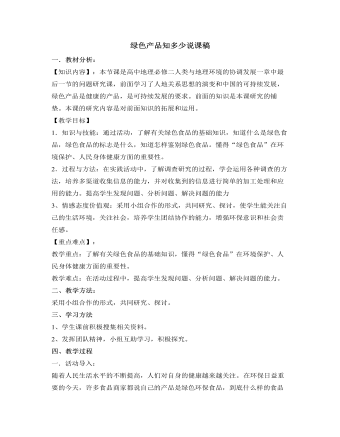
人教版高中地理必修2绿色产品知多少说课稿
各小组派代表汇报。4、教师提出问题组织学生讨论:⑴要想了解更多的绿色食品,了解绿色食品的销售情况,我们应该怎么做?⑵要想了解广大消费者对绿色食品的态度,食用绿色食品的意义,是否懂得辨认绿色食品,以及什么样的人群对此知识最缺乏等,我们应该怎么做?组织学生汇报交流。5、做个“绿色食品”广告设计师。为你喜欢的绿色食品设计广告语,每组推荐一个。6、让学生了解绿色食品认证程序。7、绿色食品打“假”队员在行动。8、向学生介绍生态绿色食品基地。三、活动总结:通过研究、探讨,了解学生对绿色食品的态度。提问:民以食为天,吃,是一个大问题,如果你的爸爸妈妈让你到超市买牛奶、方便面等,你会选择什么样的食品?为什么?希望通过今天的学习,同学们能够做到绿色消费,也希望你们向自己的家人、向周围的了解学生对“无公害食品”、“有机食品”与“绿色食品”的认识。
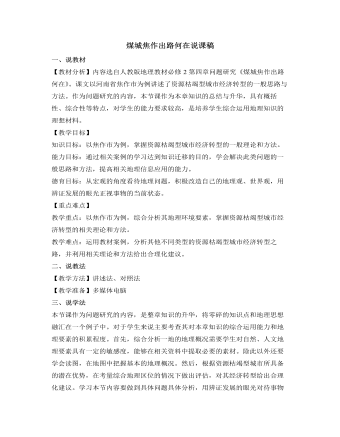
人教版高中地理必修2煤城焦作出路何在说课稿
分析过焦作市的地理概况和产业优势后,就需要针对由于资源枯竭所带来的问题提出合理化的建议。既然是谈经济转型,就应该将话题的范围明确在这一领域内。通过材料3的相关内容,我们了解到焦作市需要在产业结构调整、培育新的优势产业、增强综合竞争力等三个整改方针上下功夫。因而引导学生针对优势与不足提出建议,以三个整改方针为基准,衡量建议的可行性是锻炼学生解决此类问题的有效途径。在此我将教会学生的是解决问题方法而非案例的内容,正所谓“授之以鱼,不如授之以渔”。接下来针对学生的建议和教材资料分析所罗列的10点整改思路,由学生自由发言提出看法,通过教师的指导和学生的讨论,进而确定经济转型建议的具体方案。最后注意将建议与产业优势相对照,看建议是否都是围绕着产业优势而提出的,这样做会加深学生的印象,通过建议和优势的对应关系,将不难找出此类问题的解题思路。

人教版高中历史必修2罗斯福新政说课稿2篇
1、教材的地位作用本课是新人教版普通高中历史必修Ⅱ第六单元第18课的内容,阐述罗斯福新政的背景、措施、影响。从单元知识安排看,本课与第17课《空前严重的资本主义世界经济危机》、19课《战后资本主义的新变化》共同诠释第六单元课题——《资本主义世界经济政策的调整》。说明了“资本主义经济理论和政策随着资本主义发展而不断调整的特点”,凸显了“市场调节”和“国家干预”在经济发展中的重要性。从知识体系看,它是学生学习了第一次工业革命后自由资本主义、第二次工业革命后的垄断资本主义等之后出现的,既是对上述知识的巩固与综合运用,又为学生学习必修二的相关内容打下基础,有承上启下的作用。本课三个子目从逻辑上看又是递进关系。第一个子目“临危受命”承上启下,说明了罗斯福上台的历史背景具有临危受命的特点,第二个子目“实施新政”讲述了罗斯福新政的主要内容,第三个子目“摆托危机困境”主要讲述了罗斯福新政的影响。
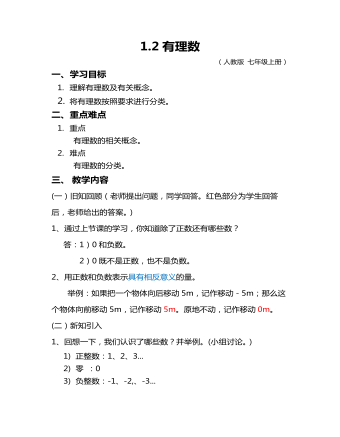
有理数教案
(一)旧知回顾(老师提出问题,同学回答。红色部分为学生回答后,老师给出的答案。)1、通过上节课的学习,你知道除了正数还有哪些数?答:1)0和负数。2)0既不是正数,也不是负数。2、用正数和负数表示具有相反意义的量。举例:如果把一个物体向后移动5m,记作移动-5m;那么这个物体向前移动5m,记作移动5m。原地不动,记作移动0m。
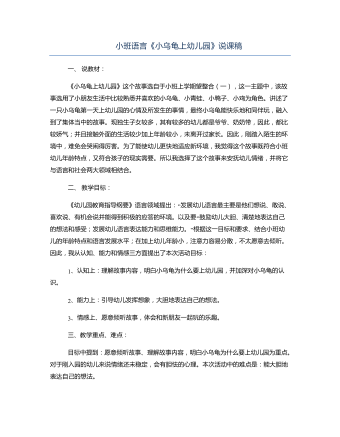
小班语言《小乌龟上幼儿园》说课稿
《小乌龟上幼儿园》这个故事选自于小班上学期望整合(一),这一主题中,该故事选用了小朋友生活中比较熟悉并喜欢的小乌龟、小青蛙、小鸭子、小鸡为角色。讲述了一只小乌龟第一天上幼儿园的心情及所发生的事情,最终小乌龟能快乐地和同伴玩,融入到了集体当中的故事。现独生子女较多,其有较多的幼儿都是爷爷、奶奶带,因此,都比较娇气;并且接触外面的生活较少加上年龄较小,未离开过家长。因此,刚踏入陌生的环境中,难免会哭闹得厉害。为了能使幼儿更快地适应新环境,我觉得这个故事既符合小班幼儿年龄特点,又符合孩子的现实需要。所以我选择了这个故事来安抚幼儿情绪,并将它与语言和社会两大领域相结合。
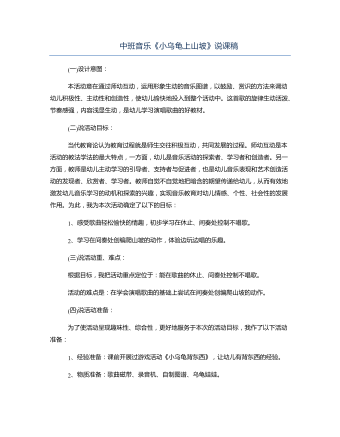
中班音乐《小乌龟上山坡》说课稿
当代教育论认为教育过程就是师生交往积极互动,共同发展的过程。师幼互动是本活动的教法学法的最大特点,一方面,幼儿是音乐活动的探索者、学习者和创造者。另一方面,教师是幼儿主动学习的引导者、支持者与促进者,也是幼儿音乐表现和艺术创造活动的发现者、欣赏者、学习者。教师自觉不自觉地把暗含的期望传递给幼儿,从而有效地激发幼儿音乐学习的动机和探索的兴趣,实现音乐教育对幼儿情感、个性、社会性的发展作用。为此,我为本次活动确定了以下的目标:1、感受歌曲轻松愉快的情趣,初步学习在休止、间奏处控制不唱歌。2、学习在间奏处创编爬山坡的动作,体验边玩边唱的乐趣。
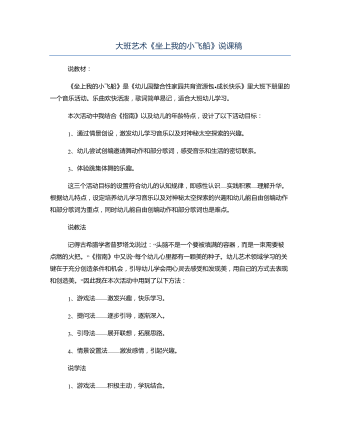
大班艺术《坐上我的小飞船》说课稿
本次活动中我结合《指南》以及幼儿的年龄特点,设计了以下活动目标:1、通过情景创设,激发幼儿学习音乐以及对神秘太空探索的兴趣。2、幼儿尝试创编邀请舞动作和部分歌词,感受音乐和生活的密切联系。3、体验跳集体舞的乐趣。这三个活动目标的设置符合幼儿的认知规律,即感性认识—实践积累—理解升华。根据幼儿特点,设定培养幼儿学习音乐以及对神秘太空探索的兴趣和幼儿能自由创编动作和部分歌词为重点,同时幼儿能自由创编动作和部分歌词也是难点。说教法记得古希腊学者普罗塔戈说过:“头脑不是一个要被填满的容器,而是一束需要被点燃的火把。”《指南》中又说“每个幼儿心里都有一颗美的种子。幼儿艺术领域学习的关键在于充分创造条件和机会,引导幼儿学会用心灵去感受和发现美,用自己的方式去表现和创造美。”因此我在本次活动中用到了以下方法:1、游戏法——激发兴趣,快乐学习。2、提问法——逐步引导,逐渐深入。3、引导法——展开联想,拓展思路。4、情景设置法——激发感情,引起兴趣。说学法1、游戏法——积极主动,学玩结合。2、观察法——自发感知,自主认识。3、合作法——相互交流,共享成果。其中游戏法很重要,因为幼儿的有意注意时间比较短,要用游戏去吸引幼儿的注意力,让幼儿乐中求学。说活动过程一、游戏情境导入:观看视频师播放“神九”发射成功的视频,幼儿观看。(“兴趣是最好的老师”,先用精彩的视频吸引幼儿的注意力,使幼儿对本次活动产生浓厚的兴趣。)师:小朋友在这个片段中看到了什么?请举手来说一说。(根据小朋友的发言,激发幼儿的好奇心,使其对太空的秘密有进一步去探索的兴趣。)
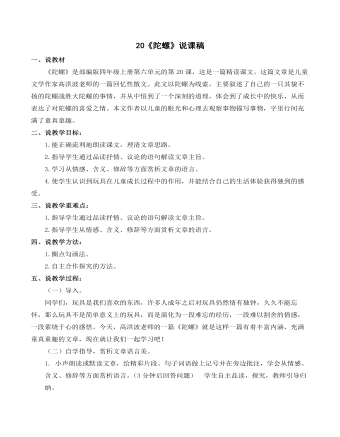
《陀螺》说课稿
在学生声情并茂的朗读后,我追问:同学们,你们猜猜他批注的可能是哪个词?有的学生说“我猜他批注的是高兴,因为我听出了他高兴的语气,并且从他手舞足蹈的动作中我想他一定很高兴所以才会又蹦又跳的。”
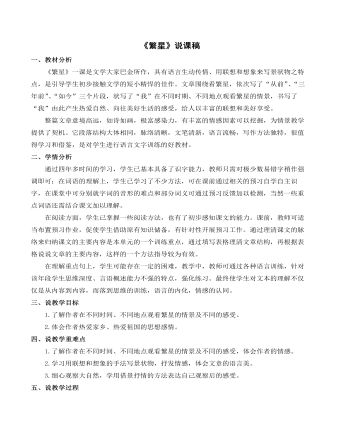
《繁星》说课稿
语文课中“文”的理解往往与“情”交织在一起,所谓“披文入情”,抑或“披情入文”皆言于此。媒体、作者和背景资料的补充,能帮助学生较好理解文本及作者所要表达的情感。上课伊始,充分利用多媒体课件,向学生展示了美丽的星空,把学生带进了一个新奇梦幻的世界。
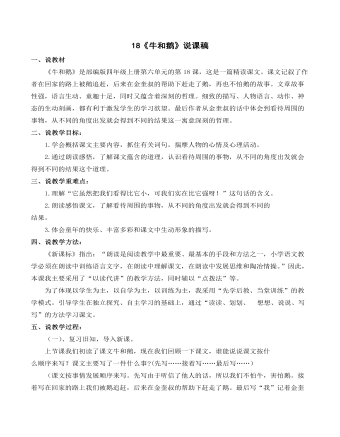
《牛和鹅》说课稿
(我们马上都不说话了,贴着墙壁,悄悄地走过去。我吓得脚也软了,更跑不快。在忙乱中,我的书包掉了,鞋子也弄脱了。)
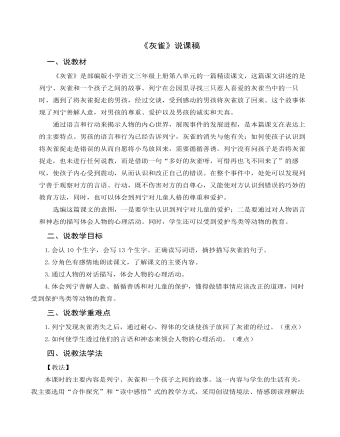
《灰雀》说课稿
为了这可爱的灰雀,列宁和一位小男孩之间发生了一个怎样有趣的故事呢?让我们带着这个问题赶快走进课文,美美地读一读吧。
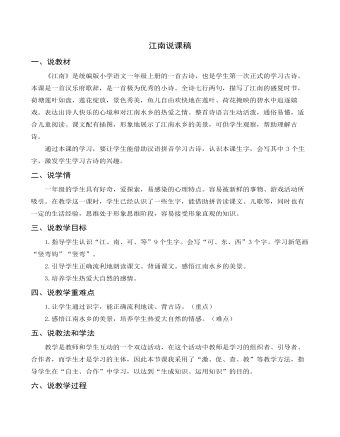
《江南》说课稿
出示贴满荷叶、荷花的小黑板,让学生上台来采摘自己喜欢的荷叶,荷叶背面有本课的生字,该生读对了生字才能摘下荷叶。通过游戏的方式学习生字,增强了趣味性,使学生能积极主动地参与到活动中来,培养学生自主学生的能力。
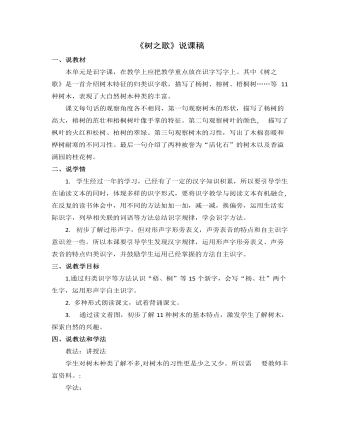
《树之歌》说课稿
普通的树木在气候不适宜的时候(譬如寒冷,干燥),因为叶子面积较大,表面没有蜡质的薄膜,而导致水分散失快,不易生存,所以在秋冬季会变黄,落叶。
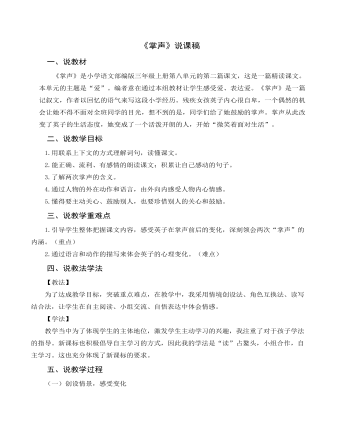
《掌声》说课稿
引导学生朗读,找出描写小英动作的词语。说一说从中读出了什么?通过让学生扮演小英,我扮演小英的朋友,让小英说出心里话。然后一起体会小英的心情,来读读这段话。
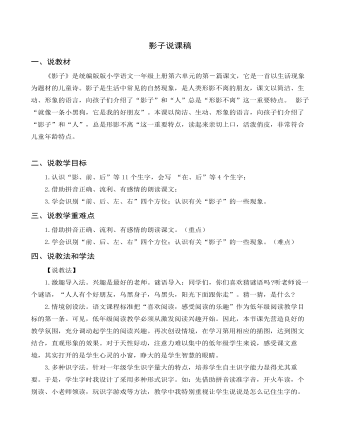
《影子》说课稿
合作学习法。以学生为本、小组合作、生生互助的形式来学习,培养学生在合作中取长补短,互帮互助的合作精神。 同组一起把生字读两遍。然后互相检查看看是否读准字音。并说说自已是怎样记住哪个字的,让学生感受合作学习的快乐。

